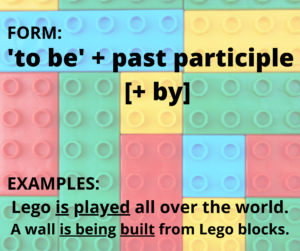Ein Meisterkurs in Advanced Grammar in Use: The Passive Voice
A Masterclass in Advanced Grammar in Use: The Passive Voice
┃Read in less than 9 minutes
Sign up here to receive the Advanced Grammar in Use: The Passive Voice handout by email:
In English, the passive voice has a bad reputation. I’ve often heard other teachers and academics say that using it is a poor writing habit and should be avoided unless in formal academic writing (and even then they say it can be problematic). Others say that it is needed in formal English to talk about rules, procedures, processes, crimes, etc. While I agree that it’s appropriate to use it in those contexts, I’m sure that the passive voice is used frequently in everyday communication too. I know this because I catch myself, and the native speakers around me, using it all the time. In this blog we’re going to look at ways in which you can, and should, use passive voice to improve your speaking skills, which is important for your Advanced test, as well as for real life.
(Look at the language in bold. See what I did there?!)

Chats over a cup of coffee
Take a look at these short conversational exchanges, which include examples of the passive:
…
Sam: You seem down. What’s wrong, Amy?
Amy: Ug, my bike was stolen last night.
(= a thief stole my bike)
…
Sam: So, is your plumbing problem sorted?
Amy: Yeah, the pipe is being fixed.Thank goodness!
(= a plumber is fixing the pipe)
…
Sam: You’re in a good mood today. What’s been going on?
Amy: Well, the house has just been sold!
(= the estate agent has sold the house)
The passive to the rescue!
There are often times that you’ll just need the passive as no other structure will be as natural or as effective in communicating what you want to say. For instance, we use it when:
- the agent is unknown
My car was broken into last weekend.
(= we don’t know who did it)
- the agent is ‘people’, ‘they’, ‘someone’ etc.
The viral’s gone viral! It‘s being shared all over the world.
(= by people in general)
- the agent is obvious from context
Have you heard about Ed? He’s has been arrested!
(= obviously by the police)
- the agent is not important
My shoes were made in China.
(= who made them is not important here)
- we don’t want to say who the agent is
I see the dishes still haven’t been done.
(= you don’t want to blame anyone)
NOTE: We use a reflexive pronoun with get to suggest that the person is responsible for their actions.
Alejandro is really into parkour. He’s going to get himself injured one day!
Activity one:
Rewrite the sentences in the passive. The subject is ‘someone’ or ‘they’. (Answers at the end of the post.)
1.Someone invited me to the party, but I couldn’t make it.
2.They’ve offered my brother a new job in Stockholm.
3.Someone is sending me a lot of spam emails.
4.Someone is going to contact you about it.

The Lego blocks of the passive
Putting together a passive sentence is like assembling Lego blocks. You need to fit everything together nicely to have a solid construction in the end.
The tense of the sentence changes by changing the form of the verb ‘to be‘. The past participle is always the same:
Lego is made in Denmark. (= present simple)
Lego is being made in Denmark at the moment. (= present continuous)
Lego has been made in Denmark recently. (= present perfect)
Lego was made in Denmark last year. (= past simple)
Lego will be made in Denmark the future. (= future simple)
And so on.
NOTE! We avoid using the passive of the perfect continuous tenses.
OK: By December, they will have been doing repairs for 6 months.
NOT OK: By December, repairs will have been being done for 6 months.
Why don’t you say it aloud? See, it just sounds weird!
Now, passive sentences always need an object, so they can only be made with transitive verbs (i.e. verbs with a direct object). ‘To make’ is a transitive verb (because you make something) e.g. a Lego house, a cup of tea, a decision. ‘To sit’, on the other hand, is intransitive because it doesn’t take an object, e.g. Tommy is sitting and making a Lego castle.
Take a look at two more examples:
His package has been delivered.
(‘to deliver’ is transitive)
Jamal’s package has arrived.
(‘to arrive’ is intransitive: The package has been arrived.)
Activity two:
Decide if these sentences can be passive. [HINT: Ask yourself if the underlined verbs are transitive or intransitive]. (Answers at the end of the post.)
1. My cat just won’t stop sneezing.
2.I remember someone asking me about that.
3.She caught her boyfriend going through her phone.
4.He usually relaxes on Sunday mornings.
So, if you want to know if a sentence can be turned into the passive, always look for the object of the verb first!

Working with ‘mood’-al verbs
Modal verbs are like emojis – they can completely change the mood of a sentence, and the passive is no exception.
Compare:
1- The lock might have been changed.
(= I can’t open the door but there could be another reason for it)
2- The lock must have been changed.
(= I can’t open the door and I’m sure this is the reason for it)
In the first sentence, we’re speculating about the possibility of lock being changed, but it’s also possible that something else happened. Simply, we’re not sure. While in the second sentence, we’re certain. We know for a fact that she got lost and there is no doubt about it. So, two different modal verbs create two very different meanings in the same sentence.
The construction of these sentences in the passive is simple. Just add the modal verb to the existing structure.
In the present it looks like this: modal verb + be + past participle.
Active: Candidates must write all the answers in pencil.
Passive: All the answers must be written in pencil.
In the past, it looks like this: modal verb + have been + past participle.
Active: I might have lost my passport on the walking tour.
Passive: My passport might have been lost on the walking tour.
Activity three:
Rewrite the sentences in the passive using the underlined modal verbs. (Answers at the end of the post.)
1.I’m afraid the film might disappoint you.
2.We can bring forward the meeting to 9am.
3.They should have told you about the changes.
4.You could have sold your car if you’d tried.

Passive -ing forms and infinitives
We can use the passive with either the infinitive or –ing form of the verb ‘to be’:
This is Tessa aka the world’s cutest kitty.
Compare:
1- My cat loves being stroked.
(= -ing form for the passive)
2- My cat expects to be stroked all the time!
(= infinitive for the passive)
Activity four:
Complete the sentences using the correct passive form of the verb in brackets. (Answers at the end of the post.)
1. I remember ____ ____ by a dog as a child. (bite)
2. I hoped ____ ____ for the basketball team. (select)
3. I resented ____ ____ so many chores. (give)
4. I hated ____ ____ by other kids on the playground. (tease)
And now, it’s over to you.
Answers:
Activity one: 1- I was invited, 2- My brother’s been offered, 3- I’m being sent, 4-You’re going to be contacted
Activity two: 1– no passive, 2- remember being asked, 3- was caught, 4- no passive
Activity three: 1- might be disappointed, 2- can be brought, 3- should have been told, 4- could have been sold
Activity four: 1- being bitten, 2- to be selected, 3- being given, 4- being spoiled






0 Comments